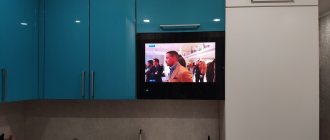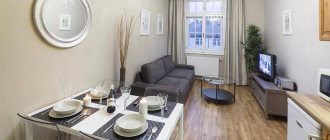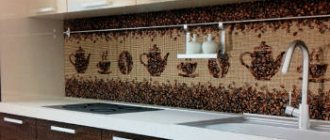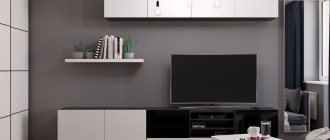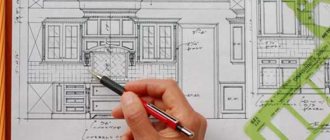Author: Andrey Fedorov
Last updated September 23, 2019
The height of placing the TV on a cabinet or wall also depends on the size of the device itself.
- 1 Basic principles of TV placement
- 2 At what height should you hang the TV on the wall in different rooms?
- 3 How to hang a TV on the wall in a children’s room at the correct height
- 4 At what height should you hang a TV in the kitchen?
- 5 At what distance is it better to be from the screen when watching TV?
- 6 How to hang a TV on the wall yourself, taking into account all standards
What is it for
Hanging a TV is seen as a great alternative to conventional installation. Thanks to this, a minimum of space is occupied, because in addition, it does not require a cabinet. But before that, you need to choose the optimal height at which it is best to hang the TV receiver.
There are several reasons for this:
- Comfort. The optimal height for viewing in the same room will be different for equipment with different screen sizes.
- Effect on the eyes. There is an optimal screen distance at which it is recommended to watch it. And the installation height also depends on it.
- Viewing angle. Viewing by one user or the whole family also significantly influences the future mounting location. Also, budget panels usually have very limited indicators.
You need to understand that these are only the main factors due to which you need to calculate the height. However, they will be different for each room. In addition, it is necessary to take into account individual criteria in a particular case.
And one more thing - hanging a TV on the wall is a labor-intensive process that is accompanied by complex safety precautions. And upon completion, the equipment is firmly attached without the possibility of position adjustment. Therefore, it is imperative to calculate the height correctly.
Installing a panel in a nursery
As for the children's room, when calculating at what height to hang the TV, rely on the child's height.
The panel should hang in such a way that children do not touch it with their heads or hands while playing; this can injure the children and also damage an expensive item. The active lifestyle of the younger generation involves watching TV from different points: from the floor, from the bed, from behind the desk or even standing. Therefore, it is difficult to calculate the optimal position; the individual furnishings of the room play a big role here.
It is important to take into account the angle of inclination so that the contrast and darkening of the picture does not harm children's eyes and does not create stress on the spine, which is not yet strong at a young age.
At what height should you hang the TV?
To calculate, first of all you need to get an answer to the following questions: What is the optimal distance from the screen?
It is calculated by diagonal and matrix resolution. For example, a small TV can only be placed nearby at eye level in a sitting position, but a large panel can be installed high, with a slight downward tilt.
Graph of the distance to the panel depending on the characteristics of its screen
What viewing format?
The main TV in the living room should be viewable from different angles, while the spare TV in the bedroom should only be visible in front of you.
The greater the vertical angle of the line of sight, the more the height of the TV installation depends on the distance
What backlight technology?
It is important to understand that LEDs emit less light compared to fluorescent lamps.
Examples of user distance from screens of various technologies
These criteria are mandatory and they will limit the range of possible heights, but do not define it precisely. When it comes to what height to hang a TV in the living room or kitchen - with the same initial data, the value will be different. The reason lies in the position - in the kitchen, the LCD panel most often cannot be placed at a small level. And each room has its own nuances.
Important ! When installing a small panel up to 24 inches on the wall directly in front of your eyes, distance calculations and backlight technology can be neglected. Regardless of them, the height will remain unchanged.
In the hall
As a rule, this is the main room where the whole family gathers. Therefore, comfortable viewing should be ensured for a large number of viewers.
The best option:
- in the middle of the wall;
- parallel to the sofa;
- at eye level in a sitting position.
The optimal height for an LCD panel in the hall
From here you can answer at what height to hang the TV in the hall. This will be 0.8 - 1.3 m from the floor to the middle of the screen.
If the room is very large and is designed to be viewed from two rows (for example, on a sofa and a bed in the back), then the LCD panel needs to be hung much higher. In this case, the lower limit is selected at which the screen will be completely visible from the back row.
In the bedroom
There won't be many options here, because... There is only one option for comfortable viewing - lying on the bed in front of the screen. There are no other users behind or closer.
Therefore, you shouldn’t think long about at what height you need to hang the TV on the wall in the bedroom - from 0.6 to 0.8 m and only in a straight vertical position, without tilting. The exception is small screens, which, in principle, are not suspended at all, because Only suitable for close-up viewing at the bedside.
In the kitchen
In this room, the user is faced with one significant limitation - not enough free space:
- headset;
- tiles, tiles;
- unfavorable places (stove, sink).
LED panel in the kitchen
You don’t always want to rearrange furniture or carefully remove tiles. It is necessary to hang the TV panel in the kitchen at the maximum height, i.e. under the ceiling and with a downward slope, in which the picture will be clearly visible from the dining table.
In the lobby
Living rooms and other spacious rooms are characterized by the presence of a large number of visitors (more than 10), and all of them need to have a comfortable view.
Example of placing a TV in the living room
It is best to hang the TV receiver at a height of up to 1.5 m, and at the same time turn all the chairs and sofas sideways towards it (for example, as in the figure above). In this position, many guests can watch it comfortably without any problems.
In the nursery
This room can be called the most varied in terms of hanging heights, so specific numbers cannot be given.
It will be determined by the following factors:
- Safety. The TV panel and peripherals should not become an obstacle for the child when running or other active games. Consider the age and height of children.
- Location. You will need to find the most optimal position for the TV that will give children a good view without putting strain on their eyes or back.
- Reliability of fastening. Children may accidentally touch the equipment, so the holder should be as stable as possible. It is better to choose a swivel bracket, because... The child is growing quickly and will need to frequently change the position of the panel.
Installation close and at a low height is an excellent option for several children of different heights, but only if they understand the rules for using technology.
Here it is enough to take into account the fact that the child is not very picky about where he sits. This can be either a soft sofa or a regular chair. And as your height increases, it is enough to change the furniture to “lower” ones. As a result of this, even as the child grows, the child’s eyes “will remain” at the level of the screen.
The same tactics can be used for hanging in a nursery with a small and adult child, by preparing different types of furniture for sitting.
Basic principles of TV placement
In general terms, there are several tips regarding the placement of LCD TVs in any living space. Everything primarily depends on how big the room is, as well as on the parameters of the TV itself.
- The height of the TV should be comfortable - it is best to install it at visual level in a sitting position.
- Try not to exceed two TV diagonals from the viewing position to the device placement point.
- There is no need to place the TV directly on the table. This place may be unstable, which is unsafe for both equipment and family members (especially children).
- Arrange a place for the TV in advance, for example, attach a shelf with the appropriate dimensions, make sure that the device fits securely into it.
- Speaking of the kitchen space, you can use special niches or brackets. This placement principle is especially relevant for small rooms.
- Do not install the TV receiver directly above the hob or near heaters. They significantly reduce the life of the TV.
- For the best viewing angle, choose a place where the screen will not be exposed to the sun's rays - ideally, use a hanging swivel bracket, through which you can adjust the direction of the TV.
From the mass of simple recommendations related to the placement of the TV, our experts have selected the main points that it is better not to exclude during installation.
The bright colors of TV images are difficult to perceive when viewed closely. Even modern, well-adapted televisions can tire your eyes.
New models of plasma TVs do not distort the image at any angle of rotation of the panel. However, looking at the screen from the side is unacceptable, so immediately install the device so that it can be comfortably viewed from any place provided in the room for this purpose.
What to consider when installing on a wall
Expert advice
Michael
Interior design specialist
Ask a Question
If installation is planned in a new apartment or house where there is no finishing yet, then you should think in advance about the design of the wall-mounted TV. If the choice is unsuccessful, the subsequent organization of the interior of the room itself will be seriously limited.
As noted above, this process requires a high level of safety precautions. And there is only one reason - the TV may break off and fall. As a result, the matrix is often broken, including up to 90% of its cost.
How to properly hang a TV on the wall - the main nuances:
- follow hanging instructions from the user manual
- the bracket and other fastenings must withstand 3 times the weight of the television equipment (for example, with its mass of 22 kg, the permissible load must be at least 66 kg);
- exclude inclined installation, if possible (the greater the angle of inclination, the higher the likelihood of the matrix falling down in the event of a break with subsequent breaking);
- installation of equipment weighing more than 25 kg on the wall should be carried out only by two people (and this not only protects against the possibility of dropping it, but also reduces the physical load on the worker, on which the quality and speed of hanging depends).
Where to place the TV in the kitchen and is it possible to install the TV above the hood or stove?
When designing a kitchen space, designers favor grouping kitchen appliances in one area or part of the kitchen unit in order to free up space in the rest of the kitchen, creating a more functional area. Installing the TV together with the rest of the equipment will help harmoniously fit it into the overall design. AVEL offers several solutions that will suit the most demanding customers. Built-in kitchen TVs have the width of standard kitchen cabinets, and the front front panel is made of tempered glass in three colors (black, white, mirror) to perfectly match any built-in appliances.
Do you want to install a TV above the hood? This is possible, because AVEL TVs are designed for such solutions and are not afraid of heat, vibration, moisture or greasy drops. The front panel of the TV can be washed with any non-abrasive means, the glass reliably protects the matrix. The standard width for 22" and 24" TVs is 60 cm, which corresponds to the most common hood size. The width of the AVS320K / AVS320KS TV is 90 cm, which is also the standard for built-in hoods and cabinets above them.
If you want to install a TV above the stove, then this issue should be taken care of even before renovating the kitchen, since not every device can cope with such a non-standard solution. Just like installing a TV behind the kitchen sink, this option requires a custom TV.
In this case, a regular TV will not only heat up, but its plastic parts may melt from the heat. The best solution would be to integrate the TV into the kitchen apron, for example, the AVS240SM model. However, it is worth remembering that the TV installed above the stove will have to be washed very often, since even the most powerful hood will not protect it from drops of fat, which will inevitably fall on the tempered glass that protects the matrix.
In our opinion, the most successful options for placing a TV in the kitchen are:
- placement of the TV in a “column” or in a single block with other built-in kitchen appliances (oven, microwave, coffee maker);
- installing a TV in upper cabinets in any convenient place, even above the hood.
Installing a TV in the kitchen in this way will not only allow family and guests to watch TV while standing or gathered in different areas of the room, but will also make your home more modern and aesthetically pleasing. Previously, this option was only available when making a special custom-made TV, but now everyone can afford a built-in TV.
The most important:
Regardless of how and where you are going to place the TV in the kitchen, you should also think about how to connect all the necessary interfaces - from power and antenna cable to various set-top boxes or a satellite receiver. That is why it is so important to think through all the details before ordering a kitchen set and before renovating the entire kitchen space.
Bracket selection
The holder should be selected based on the installation location of the TV panel and its size.
Kinds
The brackets differ according to a number of criteria, the choice among which is important to make taking into account the future use of the TV.
By mounting method:
- ceiling;
- wall;
- corner.
By adjustment method:
- Fixed . They are the most reliable, but they fix the TV receiver tightly without the possibility of adjustment.
- Inclined. They allow you to change the vertical angle of the TV and are relevant for large screens placed in a large hall.
- Tilt-rotary. Allows you to change the tilt and viewing angle of the TV.
Bracket dimensions:
- standard (VESA);
- non-standard.
The required holder size can be found in the manual for the TV receiver or by measuring the distance between the mounting holes.
This is how the size for the bracket is determined. In addition to these parameters, when choosing a bracket you need to take into account the following characteristics:
- supported weight of the equipment;
- manufacturer (in terms of quality).
How to calculate the correct distances
You can determine the correct distances between the TV and the viewer if you follow the recommendations of ophthalmologists:
Tatiana
I follow news on the mobile services market. Always up to date with the latest events
Ask a Question
Question to the expert
What should be the distance from the eyes to the screen?
At least four diagonals of the TV receiver.
How many degrees can the angle of rotation be in any direction?
Usually this figure does not exceed 15-20°. However, the maximum allowed may be 30°.
Should the viewing angle across the width be taken into account?
Necessarily. However, it should not exceed 40°.
What location of the screen relative to the eyes of the beholder is considered optimal?
When the middle of the screen is at eye level, or at least its lower third.
Installation
To install the bracket you will need the following tools:
- drill (drilling for bolts);
- hammer (hammering dowels);
- level (determining the level position between the holes);
- pencil (for marks).
An approximate plan for finding the points for the holes for the bolts will be as follows:
- place the mounting strip on the wall;
- Place a level against it from above or below and measure its level position;
- Use a pencil to make marks for drilling through the holes.
The installation process itself can be seen in the video.
Separately, it is worth considering the reliability of fastening, because... It is on this that the holding of the TV depends.
And the main thing here will not be the holder itself, but the connecting parts:
- For a small TV weighing up to 20 kg, the usual bolts included with the bracket will also be reliable. This weight is not a problem for mounting to any wall.
- If the weight of the equipment is much larger, factory bolts are not always enough. An adobe (clay) wall will not be suitable at all, and it can only be attached to concrete using dowels.
This is what the frame on which a heavy TV is suspended looks like
. The second option is preferable when additional wall elements need to be installed to the TV.
TV in the bedroom: who is a good idea for?
Bedroom television has both supporters and detractors. There are people who try to limit the amount of irritants and electrical devices in their sleeping room. However, there is also a large group of fans who watch movies in the evening, as for them this activity is a kind of relaxation before bed. It all depends on individual preferences. Installing a TV in the bedroom is recommended for people who fall asleep without problems. However, it is better to abandon this device in case of insomnia and problems with waking up in the morning, because the TV in this version can only aggravate the inconvenience.
Tips and tricks
Most often, just hanging is enough and additional work will be required to make the installation of the TV as reliable as possible.
Safety
If there are children or a large pet in the house, there is always a risk of accidentally touching the TV, after which it may fall off.
To do this, it needs to be protected from the outside space as much as possible:
- Build into the wall. This method involves punching out an opening in which the TV will be placed. It will not only be fenced on the sides, but also “hidden” in the wall, thereby not taking up space in the room at all.
- Frame. Place the TV inside the wall frame. In this case, it will only be protected on the sides and will take up part of the space in the room. However, organizing a frame requires much less time and effort compared to an opening.
Opening and decorative frame for a TV on the wall
When enclosing a hanging TV, you need to take into account the fact that it should not be placed closely in a tight frame or opening. Otherwise, heat from the operation of the equipment will accumulate, which will lead to overheating and the formation of moisture.
The recommended distance from the internal border to the body is 10% of the width or height of the equipment for side and horizontal walls, respectively. But even for a small 24-inch TV, the distance should be at least 15 cm.
The installation height from the floor and the location (relative to the horizontal) of the TV are calculated taking into account the dimensions of the opening.
Functionality
For complete convenience, you need to install a small wall shelf under the TV for the remote control and TV set-top box. Suitable material is plasterboard or wood.
Example of a stand with shelves for a TV and auxiliary devices
If the equipment is built into the wall, then a shelf is not necessary; it is enough to increase the opening area downwards to a distance of 30 cm between the wall and the screen. When the TV is installed high, then a shelf is out of the question - it’s too high under the equipment, and it’s not practical to take up additional space for one stand.
It is important to understand that such a shelf is only suitable for 1 - 2 light devices and cannot be used for home theater or acoustics.
Hiding the wires
Most often, the TV is located higher and away from the outlet. And the best way to hide the network cable coming from it is to hide it.
There are two reasons for this:
- the wire can be touched with adverse consequences;
- Often the cables contrast sharply and spoil the interior of the room.
In half of the cases, it’s easy to hide the wires from the TV without additional products:
- in the kitchen it is enough to put it under the set and other furniture;
- if the wall was sheathed, then the cord can be run under the sheathing.
An example of hiding wires in the wall (top) and using a box (bottom)
The need to hide wires often arises in the living room or bedroom.
The solution in this case depends on the format of the installation itself:
- If it is built inside the wall in the opening, then it is enough to drill a small groove from it to the socket. An excellent option in terms of interior design, but you will have to pick out the wall if the cord is damaged.
- In situations with regular hanging, a regular box will do. Its width depends on the number of viewing devices used (for example, TV + receiver). Although it clearly indicates the presence of a hidden wire, there will be no contrast with the overall interior.
As for the antenna cable, it must be hidden without any sharp bends. This can cause damage to the outer shell. As a result, the signal attenuates (which is very critical for VHF radiation, in which digital broadcasts are broadcast). It is recommended to use a wider box.
How to hang a TV correctly yourself
The procedure for mounting a TV on a wall is simple and does not require any special professional skills. All you need for fastening is protective clothing, a hammer drill and suitable fastening elements. Today, any model of bracket is equipped with a set of fasteners, which ensures reliable fixation of the TV panel on a vertical surface.
Every man can hang a TV in the house, the main thing is to calculate the optimal height and follow the instructions.
Determine a suitable wall
Modern TV models are made from lightweight materials, so the weight of models usually does not exceed 40 kg. But, despite this, they need reliable fastening, which is only possible if there is a solid surface. The walls must be made of solid materials, such as stone, concrete or brick, only in this way they can withstand a lot of weight. If the panel is planned to be attached to a partition made of chipboard or plasterboard, then it will first need to be reinforced with a metal stand or beam. Before installing the plasma, you should make sure that there are no hidden wiring or pipes in this area.
Select bracket
The types of holders have already been described in detail above. It only remains to add that these days universal or adjustable brackets are becoming more and more popular. They allow you to rotate the panel in the desired direction and change the angle of inclination. With such a device you can safely hang a TV in any room.
Insulate wires
Before installing the bracket on the wall, you should decide on the aesthetic design of the surface. Hanging wires and connecting cables can not only spoil the appearance of the interior. They may pose a potential danger to children or pets. There are three ways to insulate wiring:
- hide in the wall;
- place in a decorative box;
- equip a special TV zone.
In the first case, a groove is made in the wall where the cable is laid. The ends are brought out into a socket where the TV will subsequently be connected. Typically, these activities are planned to be carried out at the repair stage, so it is worth paying attention to more affordable methods.
The second option is considered optimal, since it hides all the wires and looks like a narrow flat protrusion.
Prepare the surface
To make holes in the wall, you will need to prepare a hammer drill with a concrete drill, and also stock up on wood drills for surfaces made of chipboard, plasterboard, and wood.
Dowels are driven into the drilled holes.
Then the bracket is mounted using bolts.
When the holder is securely fastened, you can install the TV on it.
4.9 / 5 ( 27 votes)


